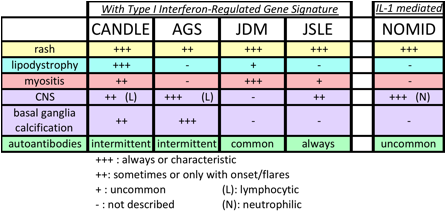Session Information
Session Type: Abstract Submissions (ACR)
Background/Purpose:
Increased interferon (IFN) regulated gene (IRG) expression has been reported in juvenile systemic lupus (JSLE)1 and juvenile dermatomyositis (JDM)2. Recently, two monogenic conditions chronic atypical neutrophilic dermatosis lipodystrophy elevated temperature (CANDLE) syndrome3 and Aicardi Goutieres syndrome (AGS)4 have demonstrated IRG signatures. The goal of this study is to characterize their phenotypic and immunologic features versus neonatal-onset multiple inflammatory disease (NOMID), IL-1 mediated disease control and healthy controls, and identify potential disease activity biomarkers.
Methods:
History, physical, and laboratory evaluation performed on 9 CANDLE, 7 AGS, 4 JSLE, 5 JDM, and 5 NOMID disease control patients (prior to IL-1 blocking therapy). Cytokine profile done on serum (ratios of means versus 3 pediatric controls) and CSF (CSF:serum ratios compared to non-inflammatory neurologic diseases)5 using Luminex (Austin, TX) assay. Gene expression analyzed with RNA-seq. Data analyzed with Partek 6.6 and Ingenuity Pathway Analysis.
Results:
A. Table of Clinical Characteristics
Systemic inflammatory markers were highest in NOMID and CANDLE patients. AGS, JDM and SLE patients were only mildly clinically active at time of sampling.
B. Serum/Plasma Cytokine Profiles
5 most distinguishing serum cytokines (Panel B, radar plots) show IP-10 was highly elevated in CANDLE and JSLE and IL-13 elevated in JDM. IP-10 and MCP-1 CSF/serum ratios were elevated for AGS. Gene expression identified upregulated IRGs for the 4 interferonpathies not present in the healthy controls or NOMID. There was a difference in disease-specific IFN signatures, with subsets uniquely upregulated and downregulated in each condition. IRGs were most upregulated in CANDLE, with greatest similarity to JSLE. AGS and JDM had other pathways higher-ranked than IFN pathways.
Conclusion:
There are specific areas of phenotypic overlap such as basal ganglia calcifications (CANDLE, AGS), lipodystrophy (CANDLE, JDM), and myositis (CANDLE, JDM, less common JSLE). Disease-specific cytokine patterns included increased serum IP-10 (CANDLE, p=0.002), increased serum IL-13 (JDM, p=0.005), and increased CSF IP-10 and MCP-1 (AGS). These differences may indicate distinct and potentially organ-specific inflammatory pathways. Disease-specific differential gene expression patterns within the IFN response signature may reflect different pathogenesis, which may be due to differing triggers of IFN response.
1Bennett L, 2003; 2Baechler E, 2007; 3Liu Y, 2012; 4Rice G, 2012; 5Pranzatelli J, 2013.
Disclosure:
H. Kim,
None;
A. Almeida de Jesus,
None;
Y. Liu,
None;
Y. Huang,
None;
G. Montealegre,
None;
D. Chapelle,
None;
N. Plass,
None;
W. Tsai,
None;
M. Gadina,
None;
L. G. Rider,
None;
A. Vanderver,
None;
R. Goldbach-Mansky,
None.
« Back to 2013 ACR/ARHP Annual Meeting
ACR Meeting Abstracts - https://acrabstracts.org/abstract/clinical-and-immunologic-description-of-pediatric-conditions-with-interferon-regulated-gene-signatures-chronic-atypical-neutrophilic-dermatosis-lipodystrophy-elevated-tempature-aicardi-goutieres-syn/


